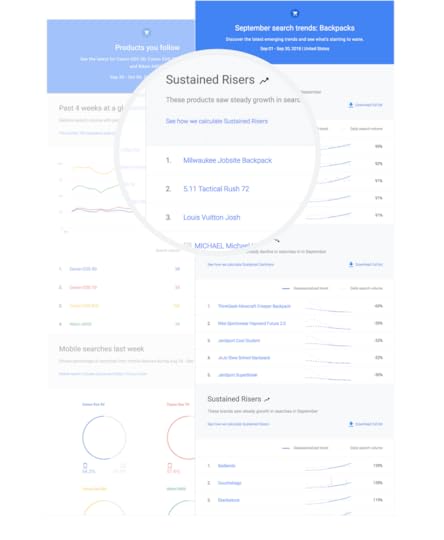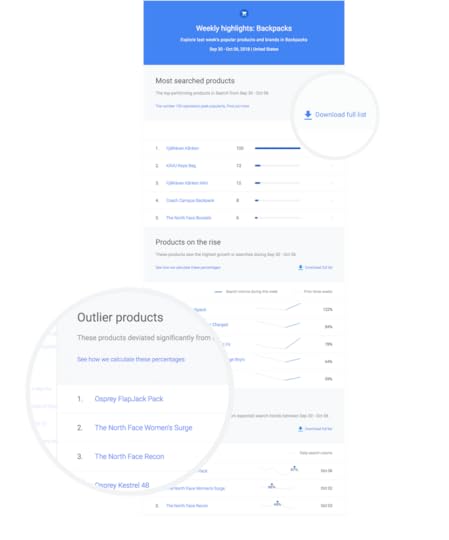Brian Meert's Blog, page 98
December 26, 2018
YouTube Originals Will Be Free for Everyone—But There’s a Catch
 December 26, 2018
December 26, 2018Anne Felicitas, editor at AdvertiseMint, Facebook ads company
 Photo courtesy of WireWag.com
Photo courtesy of WireWag.comWhen YouTube launched YouTube Red, the Google-owned company could not stop pestering users with free-trial offers, hoping they would eventually sign up for a subscription. Those days are now long gone. According to The Hollywood Reporter, YouTube is scaling back efforts to increase premium subscriptions.
YouTube Originals, a premium service that provides exclusive content such as movies and music, will be free to all users. With this change, YouTube considers releasing shows in a week-by-week basis, offering a binge option and extended-cut versions to premium subscribers.
Previously, YouTube original shows were only accessible through premium subscriptions purchased for 12 dollars a month. However, since YouTube Originals hasn’t caught on yet, likely because of fierce competition with other streaming services like Netflix and Hulu, the company will open original content to the public with a catch—the content will be supported by ads.
Ad-supported original content presents an opportunity for advertisers looking to serve ads alongside popular content. If YouTube does open ads to Originals as planned, advertisers can find their ads playing within shows such as Origins and Step Up: High Water, which both receive hundreds of thousands of views.
YouTube’s move to open Originals to the public seem to please everyone. Users who don’t want to pay for subscriptions can finally watch original content for free while users who hate ads can choose the premium option to watch shows unbothered. Meanwhile, advertisers get the ad space they’ve been needing.
Written by Anne Felicitas, editor at AdvertiseMint, Facebook ads company
The post YouTube Originals Will Be Free for Everyone—But There’s a Catch appeared first on AdvertiseMint.
December 21, 2018
Stay on Top of Trends with Google’s New Shopping Insights
 December 21, 2018
December 21, 2018Anna Hubbel, writer at AdvertiseMint, Facebook advertising company
 Rawpixel / Unsplash
Rawpixel / Unsplash Trends are always fluctuating. What’s popular today may be old news tomorrow. It can be very difficult for brands trying to optimize their marketing strategies to get their products at the top of shoppers’ search results. According to Google, 84 percent of Americans shop in any given 48-hour period in up to six different categories. With so much time dedicated to shopping, consumers expect more and want it now. How can brands anticipate those demands? That’s where Google’s new version of Shopping Insights comes in handy.
Back in October, Google introduced a new and improved Shopping Insights tool that helps advertisers better identify popular brands and products, trends, and variations of these insights across US regions. With this updated tool, advertisers have access to data for more than 55,000 products, 45,000 brands, and nearly 5,000 categories. The revamped tool also includes some new key features to help inform advertisers so they can optimize their marketing strategies according to the latest trends.
Track the Popularity of Other Brands
Knowing which brands are popular in a specific category can be very useful information when developing marketing strategies. According to Google, about nine out of 10 smartphone users do not know specifically from which brand to buy when they begin their online search. This fact is reassuring for brands that want to be discovered by new audiences. The new Shopping Insights allows advertisers to track the relative popularity of different brands in a specific category so they can adapt and optimize their marketing strategies.
Google uses the example of backpack brands. The most-searched brands over the past year were JanSport, Fjällräven, and The North Face, with the most searches occurring in back-to-school season. In contrast, during the 2017 holiday season, the luxury brand MCM was the most-searched brand. Clearly, shopping behaviors and preferences change frequently, so having access to this data weekly makes it easier for advertisers to keep up.
 Image Courtesy of Google
Image Courtesy of Google
 Image Courtesy of Google
Image Courtesy of GoogleShopping Insights can also show data related to how many searches included specific brands and how many only included generic keywords related to a given category. Using the backpack example again, the top three brands during the 2017 holiday season were only mentioned in approximately 8 percent of the queries. In layman’s terms, shoppers primarily used keywords related to the category, such as “backpacks,” as opposed to entering a specific brand name into search.
With video game consoles, however, approximately 90 percent of the queries specifically mentioned the top three brands. That means shoppers knew the brand of the console they wanted when they began searching. Both scenarios require different approaches for improving a brand’s appearance in search results.
Receive Personalized Trend Reports
Shopping Insights now allows advertisers to subscribe to receive up to 10 weekly and monthly email reports. This makes it easier to monitor the trends of specific products and categories. Google says it will share additional data on popular, growing, and trending products and brands. Monthly reports extract any seasonal or other effects from search volume to show what is truly trending up or down. Weekly reports show which products saw the most growth in the past week. Both report types provide valuable information to aid marketing strategies.
 Image Courtesy of Google
Image Courtesy of Google
 Image Courtesy of Google
Image Courtesy of GoogleNew tools keep emerging to help advertisers optimize their strategies. Back in September, Google introduced its Ad Strength tool, which measures an ad’s effectiveness prior to publication.
Anybody Can Use It
Shopping Insights is free and available to anyone in the U.S. on both desktop and mobile. It can only get better from here. Staying trend-savvy has never been so easy. Besides, being out of the loop is so passé.
Written by Anna Hubbel, writer at AdvertiseMint, Facebook advertising company
The post Stay on Top of Trends with Google’s New Shopping Insights appeared first on AdvertiseMint.
December 19, 2018
5 Social Media Changes We Will See in 2019
 December 19, 2018
December 19, 2018Anna Hubbel, writer at AdvertiseMint, Facebook advertising agency
 NordWood Themes / Unsplash
NordWood Themes / UnsplashThe social media pendulum swung heavily between the good and the bad throughout 2018. Facebook faced a national crisis with the Cambridge Analytica scandal and Russian interference in the 2016 US Presidential Election, the repercussions of which carried over into this past year. On the other end of the spectrum, social media advertising received a slew of new features and technological advancements, such as Shopping tags in Instagram Stories and a new creative suite for YouTube storytellers. The list goes on.
With the evolving patterns and events of 2018, we get a small preview of what 2019 will look like for digital advertising. Hootsuite compiled a report based on a survey, interviews, and extensive research that outlines social media changes advertisers should expect and prepare for in 2019. The report identifies five specific trends, which are discussed in this article along with examples for advertisers to refer to as they plan their 2019 social media strategies.
Change #1: Transparency and Trust
Fewer people trust businesses and social media than they did before. The Cambridge Analytica scandal, Russian interference, and the large number of fake accounts are responsible for this distrust. According to Hootsuite’s findings, 60 percent of people do not trust social media companies anymore. As a result, businesses and brands have to work harder to earn consumers’ trust.
To do that, businesses need to be authentic and transparent on social media. Hootsuite offers a few recommendations, including the following:
Create a branded hashtag that aligns with the brand’s community values. The hashtag should not focus on a product offering.
Engage in Twitter chats. These types of chats, which involve public discussions about specific hashtags, allow businesses to have community building conversations with customers.
Create a Facebook group focused on niche interests. A group allows members to engage with each other about interests related to a brand. Groups should not include promotional product or service messages.
Host monthly Q&A sessions on Facebook. Businesses can use Facebook Live streams to answer customers’ questions.
Work with a micro-influencer. Although having highly engaged social media audiences, micro-influencers have a smaller following than big-name celebrities. Consumers tend to trust micro-influencers.
Adidas created a community of micro-influencers to authentically connect and communicate with its consumers. They created “squads” of micro-influencers in the Tango Squad Program, consisting of young athletes in local communities. With the help of micro-influencers, Adidas established authentic connections with consumers.
Change #2: Stories and Social

Stories have become the most prominent form of sharing on social media. Hootsuite reports that the Stories format is growing 15 times faster than feed-based sharing. Additionally, 64 percent of the study’s participants said they have implemented Instagram Stories into their social marketing strategy or at least plan to in the next year. This means advertisers will be focusing more on visual and realistic content optimized for mobile screens as opposed to text-dominant formats.
Hootsuite recommends experimenting with a variety of Story-specific content. This requires shooting videos vertically and frequently. Additionally, content should feel raw and unedited. Hootsuite’s other recommendations include the following:
Use Stories Highlights to display content for longer than 24 hours.
Integrate a variety of creative resources to incorporate video, storytelling, text, and images into Stories for optimal performance.
Be creative with different structures, such as tutorials, behind-the-scenes, Q&As, and more.
Add UTMs to Story links to track users’ interactions with specific Stories.
Use both Instagram Stories and Facebook Stories to reach more audiences.
Try augmented reality and custom GIFs in Stories to generate more interest.
The Guardian used spontaneous, less-polished Stories to reach younger audiences. The Stories included casual language, even incorporating emojis. As a result, the Guardian’s Instagram following grew from 860,000 to one million in just four months.
Change #3: Competition and the Ads Gap
Advertisers are increasing their social media budgets to fight for more ad space on social media platforms. Social media has become a very competitive space for advertising. The number of marketers who increased their social budgets is up 32 percent in 2018, according to Hootsuite. But along with that increase is the inevitable increase in social advertising costs. As a result, marketers are refining their social strategies to get the best bang for their buck. They are also improving their organic reach to save costs.
To close the ads gap, Hootsuite says marketers should
Understand their target audience to ensure ads are reaching the right people and delivering the right value.
Define goals and metrics to understand how a campaign is performing and adjust accordingly.
Produce high-quality content to keep audiences engaged.
Repurpose high-performing organic content as ads to increase return on investment (ROI).
Experiment with new formats and split-test often to put out only high-performing and high-engaging content.
Netflix got to know its target audience to market the Canadian release of the Riverdale series. Specifically, Netflix Canada combined social media promotions with offline events across the country. Taking into account Archie fans’ familiarity with the characters, Netflix offered free Pop’s Chock’lit Shoppe milkshakes at its offline pop-up events, generating hype and interest on social media.
Change #4: Social Shopping Technologies and Sales

New technologies that make shopping on social media more seamless are emerging. As a result, more advertisers are implementing social commerce strategies. According to Hootsuite’s study, 28 percent of the participants said they either have begun using social commerce or plan to over the next year.
To become a social commerce player, Hootsuite says marketers should:
Use Instagram’s Shoppable tags or sell products in Stories.
Show products in action through images or video.
Promote products with contests.
Encourage followers to share content related to the business’s products.
Livestream product demos.
Showcase products with augmented reality.
Glossier employs a number of social commerce practices, including video tutorials, user-generated content, and photos. Each approach shows a Glossier product in action or realistic lights to give shoppers a real taste of what they’re getting. As a result, social media has contributed to 90 percent of Glossier’s growth.
Change #5: Messaging and Customer Experiences
More and more users prefer to communicate with businesses through messaging apps. Messaging apps like WhatsApp, Facebook Messenger, WeChat, QQ, and Skype account for a collective total of five billion monthly active users, reports Hootsuite. As a result, businesses are incorporating messaging features into their social customer service and marketing strategies.
Hootsuite offers the following suggestions for marketers who are just starting to dabble into messaging apps:
Enable Facebook Messenger on the business’s Facebook page.
Add plugins to the business website that direct customers to popular messaging apps.
Use automated assistant bots like ManyChat bots to communicate with customers and answer simple questions related to the business.
Try Facebook Messenger ads to engage with audiences or drive action.
Sephora created a Sephora Assistant bot for Facebook Messenger so customers could easily book makeover appointments. As a result, the company saw an 11 percent increase in bookings.
A Whole New Year of Trending Potential
 Jim Strasma / Unsplash
Jim Strasma / UnsplashThe new year is only weeks away. Since 2018 saw so many social media changes and trends, 2019 is sure to see even more. For now, we can use what we learned in 2018 to tackle the new year head-on with confidence.
Written by Anna Hubbel, writer at AdvertiseMint, Facebook advertising agency
The post 5 Social Media Changes We Will See in 2019 appeared first on AdvertiseMint.
December 18, 2018
Save the Date: 2019 F8 Conference
 December 18, 2018
December 18, 2018Anne Felicitas, editor at AdvertiseMint, Facebook advertising agency

As 2018 comes to a close, a new year will rise and along with it a new F8 conference. Tech geeks, advertisers, and social media enthusiasts, grab a pen and paper or whip out your phones to mark this date as Facebook’s 2019 F8 Conference.
F8 2019 is coming to San Jose, CA on April 3 to May 1. The announcement appeared in a blog post on the Messenger Developers site. Facebook has yet to announce the conference itinerary, but based on the previous years’ events, it will likely cover news related to AR, VR, Messenger, business tools, and more.
Although registration has not yet opened, you can sign up to receive updates from the F8 site.
Written by Anne Felicitas, editor at AdvertiseMint, Facebook advertising agency
The post Save the Date: 2019 F8 Conference appeared first on AdvertiseMint.
AdvertiseMint “Employees” Asking for Facebook Ad Account Access: Beware of Scam
 December 18, 2018
December 18, 2018Anne Felicitas, editor at AdvertiseMint, company for Facebook ads
 Rawpixel / Unsplash
Rawpixel / UnsplashToday, I received an alarming message from an AdvertiseMint group follower. Someone named Adrian Brown was asking for credit card information, she said. Although Adrian Brown claimed to work for AdvertiseMint, listing the company as his employer on his profile, he does not work for us. He is, in fact, a scammer.
 The scammer Adrian Brown attempts to take credit card information.
The scammer Adrian Brown attempts to take credit card information. This scam started three months ago. Frantic Facebook users sent us emails and messages, demanding the return of their ad accounts and pages. According to these users, fake AdvertiseMint employees requested ad account access then locked them out of their accounts and pages. In some instances the scammers asked for credit card information.
At first glance, the fake AdvertiseMint employees may appear legitimate. Their profiles resemble any other Facebook profile, complete with pictures, status updates, a sizable friends list, and the occasional post comments. If you question their identities’ authenticity, they’ll confidently state their position at AdvertiseMint and send a link to our website.
 Joan Hodge, scammer, stole a user’s Facebook page.
Joan Hodge, scammer, stole a user’s Facebook page.But these people aren’t who they claim to be, using AdvertiseMint’s name to swindle business owners out of their ad accounts and personal information. If an “employee” from AdvertisMint asks for ad account access or credit card information, be wary and look for these red flags.
The Facebook Message
No AdvertiseMint employee will contact you from a personal Facebook profile. We will contact you either from our professional AdvertiseMint emails (name.lastname@advertisemint.com), from the contact number listed on our homepage, or from AdvertiseMint’s Facebook Messenger. People sending messages from their personal Facebook accounts on behalf of AdvertiseMint are scammers.
 To speak to AdvertiseMint on Messenger, visit our Facebook page.
To speak to AdvertiseMint on Messenger, visit our Facebook page. The Get-Rich-Quick Proposal
The scammers employ different deceptive tactics to steal people’s ad accounts and credit card information. In one instance, the scammer offered his victim a blogging job, promising a Paypal payment of $2,800 to $3,400 in exchange for three or four articles. If that sounds too good to be true, that’s because it is. A person offering you a large sum of money through Paypal for very little work is a scammer. If you want to work for AdvertiseMint, you can refer to our Careers page.
The Request for Credit Card Information
Any stranger asking for credit card information is likely a scammer. Granted, our agency will ask for credit card information during the sign-up process so we can charge you for ad payments and agency fees. However, this request is only done through our Agency Agreement, which you must complete before working with us. We will never ask for credit card information through the phone or through our personal Facebook accounts.
The Foreign Language
AdvertiseMint is an American company based in Hollywood, California. Although we employ individuals who are fluent in different languages, we always communicate to clients in English. Thus, anyone who sends you a message on Facebook in a foreign language, claiming to work for AdvertiseMint and asking for personally sensitive information, is likely a scammer. So far, the pattern has been the same: the scammers contact individuals in Spanish-speaking countries and converse in fluent Spanish. This leads us to believe that the scammers are based in a Spanish-speaking country.
 Adrian Brown contacts people from Spanish-speaking countries.
Adrian Brown contacts people from Spanish-speaking countries. What to Do
An “AdvertiseMint employee” sent you a suspicious message, and, after reading this article, you find that the “employee” ticked off all the red flags. The next steps are easy. Take a screenshot of your conversation with the scammer, copy the URL of the scammer’s profile, and send the screenshot and the URL to AdvertiseMint by messaging our Facebook page or contacting us on our website. We will send the URL to Facebook to take down the scammer’s account.
These scammers have caused AdvertiseMint and innocent Facebook users trouble. Keep your eyes peeled and be wary of any suspicious messages.
By Anne Felicitas , editor at AdvertiseMint, company for Facebook ads
The post AdvertiseMint “Employees” Asking for Facebook Ad Account Access: Beware of Scam appeared first on AdvertiseMint.
December 16, 2018
How to Create Facebook Ads That Direct to WhatsApp
 December 13, 2018
December 13, 2018Anna Hubbel, writer at AdvertiseMint, Facebook ad agency

Facebook advertising offers a variety of unique ways to communicate with your audience. It even allows you to start conversations that open to other Facebook-owned platforms, such as WhatsApp.
WhatsApp is a text, voice, and video messaging app used by more than 300 million daily active users. This past October, Facebook introduced ads that users can click to open a chat with your business in WhatsApp. These ads include a call-to-action button at the bottom right of your ad creative that users can select to open WhatsApp if they prefer to communicate with your business that way.
Here’s How
Before you can create a Facebook ad with a WhatsApp call to action, you must first download WhatsApp Business for Android and connect your WhatsApp account to your Facebook page. You must also be your page’s admin.
Step 1: Open Ads Manager and navigate to Ads Creation.

Step 2: Choose your objective. Currently, the WhatsApp call-to-action is only available for the messages, traffic, and conversions objectives.

Step 3: Select WhatsApp in the “Message Destination” section.

Step 4: Define your audience, budget, and campaign schedule specifications. Note that you cannot target users under 18 years old.
Step 5: Choose the images, text, and headline for your ad in “Ad Setup.”
Step 6: Review your campaign and then click “Confirm.”
Now you can easily reach an audience who prefer chatting through WhatsApp, creating a seamless customer experience with your business.
Written by Anna Hubbel, writer at AdvertiseMint, Facebook ad agency
The post How to Create Facebook Ads That Direct to WhatsApp appeared first on AdvertiseMint.
December 14, 2018
Why Are Users Unfollowing You? Instagram Creator Account Will Tell You
 December 14, 2018
December 14, 2018Anne Felicitas, editor at AdvertiseMint, Facebook advertising agency
 Phil Desforges
Phil DesforgesYou log in to your Instagram profile to find an exciting surprise—you finally reached one million followers! You utter a high-pitched squeak, elated to see this milestone. Wait till your friends hear about this…
In a split second, your follower count drops from one million to 100k to 99k to 89k. What is happening? Why are people leaving? What did you do wrong to deserve this cruel injustice?
Instagram followers rise and fall like a dizzying Six Flags roller coaster. Often, the reasons for their sudden abandonment is unbeknownst to you. Was it because of your latest workout post?
With Instagram’s new creator account, you no longer have to wonder why followers are leaving. The new account category comes with tools to satisfy influencers’ needs, such as growth insights and messaging filters.
As reported by The Hollywood Reporter, Instagram is testing creator accounts for high-profile influencers and celebrities. Currently, Instagram offers two profiles for users, personal and business. A personal account is the default option used by regular Instagrammers. A business account provides tools for businesses and brands, such as insights and profile call-to-action buttons.
The new creator account contains tools unavailable to business and personal accounts. One is the growth insights tools, the most notable feature of them all. It helps influencers monitor and understand their following by showing them weekly and daily data on the number of follows and unfollows, as well as the content that triggered those events.
The creator account also has Direct tools that help influencers filter messages as read, unread, and flagged, a welcome feature to those who often receive a large influx of messages from fans and brands. The account also allows influencers to remove the call or email call-to-action button from their profiles.
According to The Hollywood Reporter, Instagram is testing the creator account with a small beta group. Next year, however, the social media company will roll out the account to a wider community. I bet you’re hoping that’s you.
Written by Anne Felicitas, editor at AdvertiseMint, Facebook advertising agency
The post Why Are Users Unfollowing You? Instagram Creator Account Will Tell You appeared first on AdvertiseMint.
Facebook Is Testing Infomercial-Style Live Videos
 December 14, 2018
December 14, 2018Anne Felicitas, editor at AdvertiseMint, Facebook ads company

Facebook takes e-commerce to the next level with live infomercial-style videos. According to Tech Crunch, the social media company is testing a live video feature that allows sellers to demo and describe their products to page followers.
Before going live, Facebook will notify followers that the seller will broadcast a video to describe and demo a product. During the broadcast, sellers can answer questions and respond to comments. They can also take reservations and request payment through Messenger. Facebook does not take a cut from the payments.
This new feature presents an exciting opportunity by merging traditional and social media advertising. The live videos mimic TV infomercials, in which sellers demo and provide details about their products to customers who can call in for an order. If rolled out, this feature may improve sellers’ relationships with customers and increase sales.
The test is only available to a small group of page owners in Thailand, although some sellers may be waitlisted.
Written by Anne Felicitas, editor at AdvertiseMint, Facebook ads company
The post Facebook Is Testing Infomercial-Style Live Videos appeared first on AdvertiseMint.
December 12, 2018
Facebook Tests Search Ads with a Small Group of Advertisers
 December 12, 2018
December 12, 2018Anne Felicitas, editor at AdvertiseMint, Facebook advertising agency
 Agence Olloweb
Agence OllowebAccording to Tech Crunch, Facebook is testing ads in Facebook and Marketplace search results. Currently, the test is only available to a small group of e-commerce, automotive, and retail advertisers in the United States and Canada. If successful, Facebook will expand the test to other countries.
The search ads, as reported by Tech Crunch, will contain features similar to News Feed ads: a headline, an image, a copy, a link, and a “Sponsored” label. They will also have a “hide” option for users. Unlike News Feed ads, however, search ads are limited to the single image and carousel formats. These ads may look drastically different from feed ads, or they may look similar. Facebook is still developing the design.
The placement option for search ads will appear in Ads Manager to the small group of advertisers. The ads will not appear on desktop devices, only on Android devices. The Marketplace search ads, specifically, will appear to iOS and Android. Advertisers cannot choose target keywords the way they would with Google ads. Instead, the ads will appear in search terms related to auto or retail topics.
Written by Anne Felicitas, editor at AdvertiseMint, Facebook advertising agency
The post Facebook Tests Search Ads with a Small Group of Advertisers appeared first on AdvertiseMint.
Google Is Now Disney’s Core Ad Technology Platform
 December 12, 2018
December 12, 2018Anna Hubbel, writer at AdvertiseMint, Facebook advertising agency

Clayton Cardinalli
Google wished upon a star and the result is a new global partnership with the Walt Disney Company. In a blog post, Google announced that Google Ad Manager is now Disney’s core ad technology platform. Disney will deliver high-quality video ads across the web, mobile apps, and live streaming through the technological magic of Google.
The goal of this new partnership is to deliver relevant, seamless, and measurable ad experiences across all screens, wrote Google’s Chief Business Officer Philipp Schindler. Audiences today bring their video entertainment experiences with them wherever they go, so digital advertising needs to accommodate those routines.
“People today exercise greater control over what they view and when—and on which screens—they view it,” said Schindler. “They watch sitcoms in taxis and on trains and stream news and documentaries at the gym. All of which contribute to a striking new reality: TV is no longer a stationary box anchored to a corner in your living room.”
Google and Disney have similar visions, Schindler wrote. “Disney and Google share a passion for bringing quality content and information to everyone, everywhere. With this new relationship, Disney will bring its entire global digital video and display business onto Google Ad Manager, which will serve as its core ad technology platform.”
The partnership means Google will power digital advertising for major Disney entities such as ABC, ESPN, Marvel, Pixar, Star Wars, and, of course, the Disney brand itself.
Together, Google and Disney plan to transform the traditional conceptualization of the commercial break. Audiences will feel less inclined to walk away, skip, or move on to something else, giving more value to the digital ads that advertisers deliver.
Schindler concluded, “Together, we plan to build an advanced video experience for Disney that will transcend devices, platforms, and living rooms to bring the magic of premium video content into people’s hearts, minds, and screens—everywhere.”
Google is broadening the scope of what’s possible in digital advertising on a search engine platform. Earlier this year, the company introduced its Ad Strength tool, which allows advertisers to measure the effectiveness of an ad before publishing it. The company also introduced Showcase Shopping ads and Shoppable Images just in time for the holidays. Additionally, the company announced a new Follow feature for Google Maps to make it easier for users to keep up with their favorite businesses.
Google is breaking ground for new digital advertising experiences, and now Disney is part of that world.
Written by Anna Hubbel, writer at AdvertiseMint, Facebook advertising agency
The post Google Is Now Disney’s Core Ad Technology Platform appeared first on AdvertiseMint.



